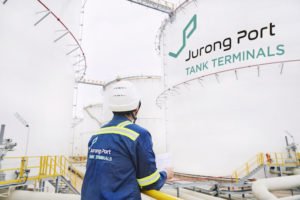Singapore expands MGO storage capacity with Jurong Port’s new terminal

Singapore has better positioned itself to meet the upcoming IMO 2020 sulphur cap regulation by having larger storage capacity of clean marine fuels following the opening of the new Jurong Port Tank Terminals (JPTT) this week.
On Monday, Singapore’s Jurong Port and Germany’s Oiltanking officially opened JPTT, a joint venture project in the making since Phase 1 construction started in May 2017.
“We now have 252,000 cu m of tank storage under Phase 1 of the project occupying some 12 hectares at Jurong Port,” said Ooi Boon Hoe, ceo of Jurong Port and chairman of JPTT, adding that the capacity is all for clean petroleum product storage such as marine gasoil (MGO).
“We can be useful in supporting Singapore’s bunker hub status by way of MGO storage. As Singapore is likely going to be short in MGO and supply areas (of MGO) will probably be from North Asia, MGO is going to be moved in larger vessels like suezmax, and we are suezmax capable,” Ooi told Seatrade Maritime News.
JPTT is supported by four deepwater berths capable of handling tankers up to 180,000 dwt. The terminal is connected via pipelines to the Jurong Island petroleum and petrochemical network, enabling seamless transfer of products for storage, distribution and trading.
“When the refineries need to crank up production of MGO because of potentially higher demand in future, we can directly store the product,” Ooi said.
Ooi pointed out that JPTT is also considering the possibly of offering direct bunkering for its berths to load MGO onto bunker vessels, thereby shortening the supply chain.
PetrocChina has taken up 100% of JPTT Phase 1 tank capacity. A Phase 2, scheduled to be completed in the next 18 months, will add 310,000 cu m of clean products capacity, bringing the total storage capacity to 562,000 cu m.
With an increasing emphasis on environmental sustainability, the IMO has imposed requirements for bunker fuels to contain a maximum sulphur content of 0.5% from 1 January 2020.
Chee Hong Tat, Singapore’s Senior Minister of State at Ministry of Trade and Industry, noted that the JPTT development provides opportunities for Singapore to enhance its position as one of the world’s top bunkering ports for low sulphur fuels.
“JPTT is purpose-built to handle clean petroleum products, including bunker fuels that comply with IMO’s regulations,” Chee said.
JPTT is expected to handle about 7m tonnes of clean petroleum products annually.
HEADLINES
- Do shipping markets want Biden or Trump for the win?
- All 18 crew safe after fire on Japanese-owned tanker off Singapore
- Singapore launching $44m co-investment initiative for maritime tech start-ups
- Cosco debuts Global Shipping Industry Chain Cooperation Initiative
- US warns of more shipping sanctions
- China continues seaport consolidation as Dalian offer goes unconditional